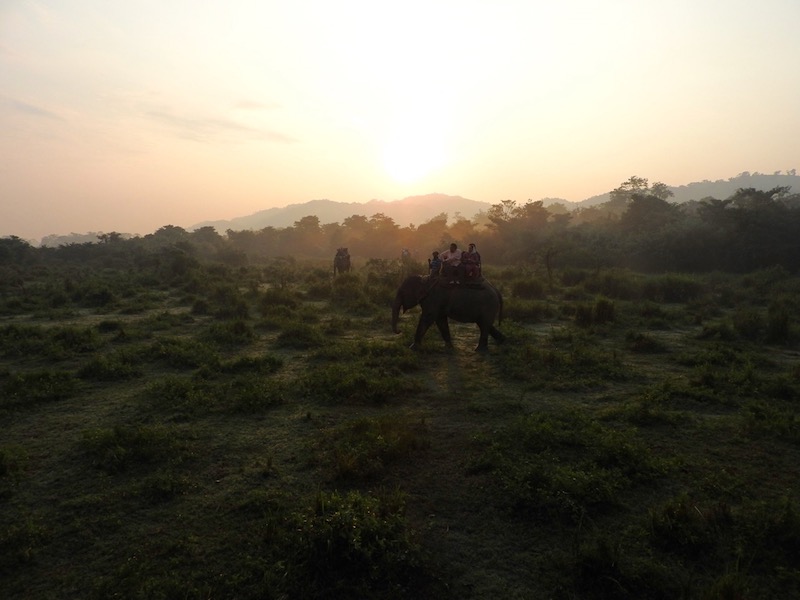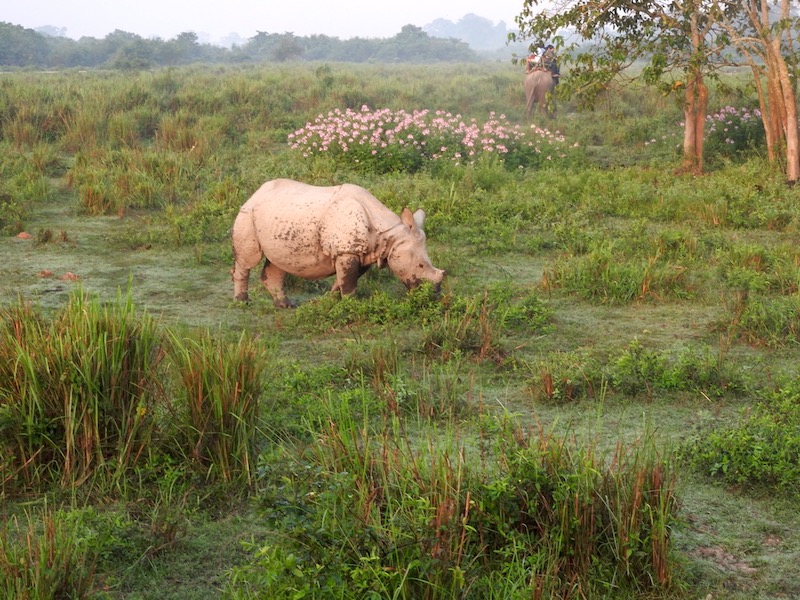
Woken up at an ungodly hour in the morning by a shrieking alarm clock, I shivered in the icy winter air of Northeast India. My mind entirely focused on the warm bed that stretched out invitingly, I wondered aloud why were we going out into the cold morning in search of the rhinoceros, of all things. And then I remembered – was reminded by the husband actually – that we had travelled across the country, all the way to Kaziranga in Assam, just for a glimpse of these animals in the wild.
The one-horned rhinoceros once thrived across the flat plains of north and northeast India, but uncontrolled poaching has left it endangered, almost at the brink of extinction. Today, the best (and possibly only) place in the country to spot the Indian rhino is the Kaziranga National Park, just a few hours drive from Guwahati.
This forest had been on our travel list for years, but somehow every time we planned a wildlife holiday, it was the siren song of the tiger in the Indian heartlands that prevailed. This holiday, we had set aside sufficient time for this pursuit, after which we were to make our way across other parts of the state. Funnily enough, this forest is also officially known as the Kaziranga Tiger Reserve, although the hero here is undoubtedly these thick-skinned mammals that have survived several rounds of evolution that eliminated other weaker species.
A grey mist hung low in the air as we drove up to the Bagori Gate of the Western Range in the semi darkness. There was already a large crowd waiting at the watch tower from where the elephant safari begins; a scene of utter noise and chaos despite everyone holding prior bookings for a specified time. “I hope we don’t end up sharing this safari with people who think it is fun to play music in the forest and yelp at the sight of animals,” I muttered wearily, thinking of the bane of wildlife enthusiasts who go out regularly into the Indian jungles.
Fortunately for us, we had a quiet morning in the forest, with birdsong as the only background noise. Kaziranga is not really a dense forest in the way of those of central India, but almost entirely flat. While the grasslands make it the perfect habitat for the rhino, it also sometimes grows tall enough to hide the entire animal. Luckily, the grass was still short and dry in parts when we visited, making it easy to spot the animal even from a distance. And we were anyway on elephant back, which meant both a vantage point of view as well as access into the grasses and marshes where jeeps cannot go.

Crossing the shallow stretch of water a few minutes into the safari, I turned back to capture a picture postcard moment; half a dozen elephants silhouetted against the golden rising sun. Up ahead, there was a minor commotion, with all the mahouts guiding their elephants towards the cluster of bushes, a sure sign that a rhino had been spotted.
As it turned out, it was not one but three rhinos grazing peacefully, ignoring the admiring crowds with great aplomb. Eager tourists around us were urging their mahouts to get closer and closer, but nothing seemed to faze the trio. There was a tree in full bloom right behind them, and for a moment, framed against the pretty pink flowers, it was almost possible to think of the rhinos as beautiful animals. And then one of them turned around to show his back to us, and the spell was broken.

The rest of the safari was a vain search for more of these mammoths, with the mahout claiming that we had been lucky, since sightings had been low this season. By the end of it, I was lulled into sleep by the gently rocking motion of the elephant. Unlike the thrill of the tiger chase, where every moment holds a possibility, and every animal noise sounds like an alarm call of the deer, this safari was a mellow and slow affair, with enough time to admire the stunning landscape, bounded by the mighty Brahmaputra river.

It was only on the way back to the guesthouse that I noticed how the roads were lined with lush tea estates, from where Assam tea was possibly exported to the world. The sun was up and workers had already begun their tasks for the day, wicker baskets hanging on their backs, into which the tea leaves went steadily. The plan was to head to the village of Panbari, a few kilometres away, for a glimpse into rural life in this part of the country.
On the way, we stopped for a quick look into the CWRC (Centre for Wildlife Rehabilitation and Conservation) campus to see the way injured animals, including elephants and rhinos, are given medical care. Over the last 14 years, CWRC has treated over 3500 cases of animals (over 230 species, they say) in various kinds of distress. The sight of a baby rhino being given milk through a feeding bottle was particularly endearing, one that left me smiling for the rest of the morning.
After lunch at a local home in Panbari, we headed back to the forest for an afternoon safari, this time on a jeep from the Central Gate at Kohora. This ride was an exercise in bounty, where we spotted over 25 rhinos in the course of two hours. “This rarely happens,” our driver Uttam exclaimed, adding, “sometimes tourists have even asked me for a refund because we did not come across any rhinos!”
In our case, we saw them solitary and in small groups all along the route, resting, grazing, taking a dip in the cool water. And right at the end, when the sun was about to set, and I had put away my camera, we had our best sighting for the day; a mother and kid rhino frolicking together in the grass, the adult making mock charges with the horn pointing at the little one. “Madam, this is a lucky day for me also,” Uttam smiled warmly, as he dropped us back at the main gate.

Kaziranga has been on the UNESCO World Heritage list since 1985, one of the seven natural sites in India, the continued status of which is dependent on the conservation activity in the park. This forest has an interesting history, from the time Mary Curzon, wife of the then Viceroy of India, Lord Curzon, returned disappointed from the Kaziranga area without sighting a single rhino in 1904. As a result, she urged her husband towards rhino conservation, thus leading to the formal creation of this forest spread over 232 square kilometres in 1905.
It was only seven decades later, in 1974 that it was extended to cover 430 square kilometers, and given protected National Park status. It somehow feels fitting that over a century after Lady Curzon’s visit, British Royalty, in the form of Prince William and Princess Kate chose to visit the far-flung forest of Kaziranga, listening to stories of wildlife conservation efforts in the area.
Whenever we head to the forests, the husband and I keep our eyes peeled for not just the big fauna but also the smaller ones that form a significant part of the ecosystem, and the birds. This time, however, the attention was all on the one-horned rhino, which graced us with its presence several times in the day. May its tribe increase!
***
Published in the Weekend supplement of Khaleej Times in May as ‘In search of the one-horned rhinoceros’




